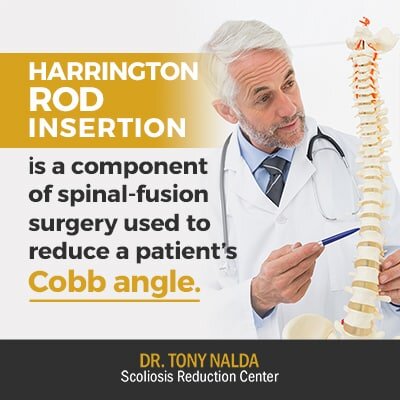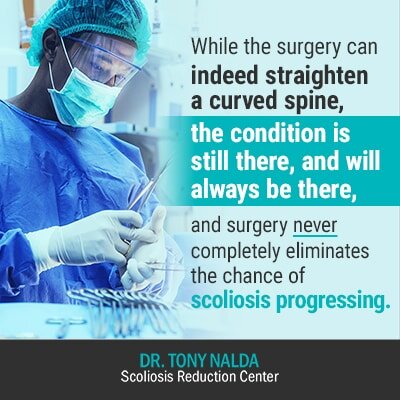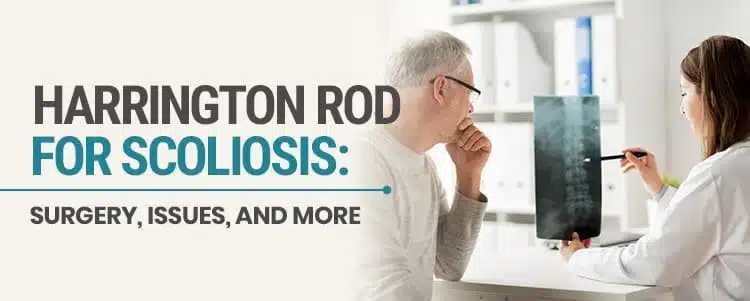When a person is diagnosed with severe scoliosis, meaning their Cobb angle is over 45 degrees, spinal-fusion surgery is often recommended; this is especially true for those following the traditional treatment path. While attaching a Harrington rod to a fused spine helps reduce the Cobb angle, there are many potential risks and side effects.
There are different treatment approaches people can take when it comes to managing their scoliosis. As it is a progressive and incurable condition, the decision of which approach to take is an important one because treatment results will shape the person’s experience with their condition. Before we talk about alternative approaches to treatment, we’ll first take a look at the traditional choice of spinal-fusion surgery.
What is a Harrington Rod?

The Harrington rod is a metal rod that is commonly used in scoliosis surgeries performed in the United States.
Harrington rod insertion is a component of spinal-fusion surgery used to reduce a patient’s Cobb angle. This surgery is a lengthy and invasive procedure that involves using a ratcheting system to insert the Harrigton rod along the abnormal curvature’s concave side (inner edge of the curve).
The rod is attached to the spine with two hooks: one at the curve’s top and one at the bottom. Next, the surgeon will use the ratcheting system to stretch out and straighten the curved spine. After the spine has been stretched and straightened, the actual fusion takes place.
Fusing the spine involves removing the spinal discs that sit between the vertebrae in the curve so the individual vertebra can be fused together into one solid bone, straightening the curve. This is no small thing, especially in light of the important functions that the discs of the spine perform: they cushion the vertebrae, facilitate flexibility, and help to evenly distribute force along the spine.
The spinal discs that are removed are often replaced with bone grafts taken from the patient’s hip.
Results of Harrington Rod Surgery
While Harrington rod surgery can be considered a success in terms of straightening a crooked spine and decreasing the patient’s Cobb angle, I have to point out what happens to that portion of the spine that has been fused.
The portion that’s been fused will never be able to bend and twist as it did before. In fact, there is generally a 25-percent loss of mobility post-surgery. The amount of extra pressure that is placed on the other areas of the spine that have to compensate for the fused area can also cause additional pain and discomfort.
The final fusion can take weeks or months to fully complete. The role of the rod is to support the fused spine during the healing process and into the future.
In addition to the loss of flexibility, there is the danger of having a spine that’s less able to absorb force. I’ve had two patients, one who had spinal-fusion surgery and one who had undergone my alternative treatment approach. Both were in a car accident, and the force of the impact snapped the fused spine of the one patient, while the other’s spine was able to withstand the force.
There are also the psychological ramifications of living with a rod attached to your spine. People often don’t consider this effect, but it can be substantial. Patients report feelings of anxiety over not trusting the strength of their spine, the rod, screws, or hooks. Many no longer enjoy the same activities they did pre-surgery and are hesitant to try new things.

As said earlier, scoliosis is incurable, so if a patient is considering spinal-fusion surgery as a potential cure, they will be sorely disappointed. Harrington rod surgery isn’t a cure because it doesn’t address the underlying cause of the condition, but a symptom of it: the curved spine.
While the surgery can indeed straighten a curved spine, the condition is still there, and will always be there, and surgery never completely eliminates the chance of scoliosis progressing.
Harrington Rod Issues
Most surgeons and scoliosis specialists following the traditional treatment route will recommend spinal-fusion surgery for patients with a Cobb angle measurement of 45+ degrees.
For children, or adolescents who have yet to reach skeletal maturity, Harrington rod surgery carries additional risks. For spines that are still growing and have had spinal-fusion, these patients are at a much higher risk of experiencing progression above and below the site of fusion; this result is referred to as ‘Crankshaft phenomenon’.
There are also the potential issues of a child or adolescent outgrowing the rod, and in these types of cases, the only option is subsequent surgeries to remove the first rod and replace it with another.
There is also the fact that every type of hardware has a lifespan. There simply haven’t been enough long-term studies to find out just how long these rods, screws, and hooks will last before risking degeneration or breaks.
Most follow-ups are two to five years post-surgery, but we really don’t know what life looks like for people 40, 50, and 60 years post Harrington or titanium rod surgery.
Additional Risks and Complications
Any surgery comes with risks and added complications, and spinal-fusion is certainly no exception. The surgery is lengthy and invasive, and there are a number of potential risks and surgical complications that anyone considering it should be aware of:
- Excessive bleeding during surgery
- Infection
- Fusion not working
- Increased progression post-surgery
- Development of Flatback syndrome
- Risk of partial or full paralysis
- Subsequent surgeries to remove failed hardware
- Loss of strength and flexibility in the spine
This is why Harrington rod surgery is not a decision that should be made lightly. There are extreme situations where surgery is recommended because severe scoliosis is causing related complications such as lung impairment and cardiac issues, but even in those cases, I highly recommend trying a more natural alternative form of treatment first.
Alternative Treatment Options
There are far more scoliosis treatment options available today than there were in the past. Here at the Scoliosis Reduction Center®, we support and deliver a conservative approach that addresses the underlying cause of scoliosis, rather than merely treating symptoms of it.
Our Center provides patients with access to multiple forms of treatment in one accessible location. We combine scoliosis-specific therapy, rehabilitation, chiropractic, and corrective bracing to achieve a curvature reduction at a structural level.
We customize each and every treatment plan so that they address the individual characteristics of the patient and their condition. Our approach carries few, if any, side effects and potential complications, so why not try a more natural approach first?
Here at the Center, we educate our patients on all treatment options available to them, but I certainly encourage them to try every treatment option available to them before even entertaining the possibility of undergoing as invasive, costly, and irreversible a procedure as spinal-fusion surgery.
Conclusion
While spinal-fusion surgery has changed over the years in terms of the types of hardware used, the actual procedure and approach remains the same.
The idea is that hardware is attached to the spine to hold the fused portion in place while it forms into one solid bone. This doesn’t come without a cost, however, as the fused portion loses its spinal discs and flexibility.
Not only is Harrington rod surgery costly and invasive, it can’t promise permanent results. Even if the surgery is considered a success because the patient’s Cobb angle is decreased and their spine is straighter, there is still the risk that progression can continue post-surgery.
There is also the risk of hardware snapping, degrading over time, or breaking. I’ve seen patients who have had screws come loose, and it’s not a simple fix. Once you’ve had your spine fused, there is no way to unfuse it.
If a post spinal-fusion surgery follow-up doesn’t show positive results, the only additional treatment option, at that point, is to have more surgeries, which of course carries more risks.
There is a time and a place for spinal-fusion surgery, but I believe that time and place should only be after all other treatment options have been exhausted. Here at the Scoliosis Reduction Center®, we take great pride in being able to provide a conservative natural approach to patients, along with the benefits it entails.





